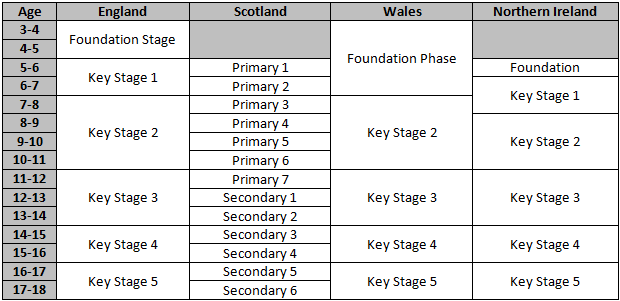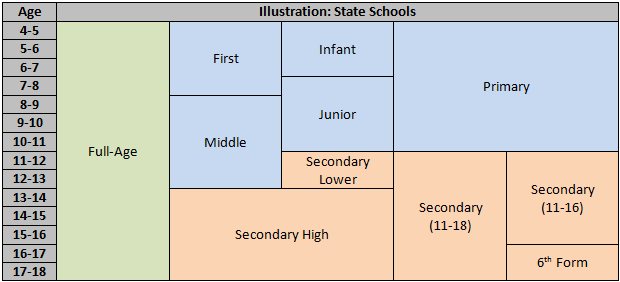A lesson in school types
As a union of four nations, the UK contains a myriad of school systems, governance models, teaching systems and assessment regimes. While it’s important to acknowledge those differences, we can also pick out commonalities to help with our understanding.
Phases of education
Broadly speaking, the UK education pathway can be outlined as follows:
- Early Years/Foundation Stage
- Primary
- Secondary
- Further Education
- Higher Education
- Adult Education/Lifelong Learning
However, as with any general rule, there are always exceptions, such as full-age schools teaching pupils aged 4 to 18 and some regional anomalies where pupils attend first schools (aged 4-7), middle schools (aged 8-13) then high schools (aged 14-18).

Early Years: Are nurseries & playgroups that different?
Actually they are… The difference between early years settings primarily revolve around staff ratios and inspections, but other distinctions include the age ranges looked after and whether they open outside of term time.
Primary & Secondary: No NEETs
Under the ‘Education and Skills Act 2008’ the Labour Government raised the upper age of compulsory learning so that “by 2013, all 17 year olds, and by 2015, all 18 year olds, are participating in some form of education or training.”

Of course, nowadays there are many different types of these schools due to the multitude of governance and funding models. In our glossary you can find out more about Academies, Free Schools, University Technology Colleges and many more.
England
Education in England is overseen by the Department for Education (DfE).
Independent schools aside, there are six main types of state schools in England:
Community Schools are managed by the local authority. The LA owns the buildings and land, employs the staff and is responsible for admissions.
Voluntary Controlled Schools are typically faith schools where a charitable trust owns the buildings and land, but the local authority employs the staff and manages the admissions process.
Voluntary Aided Schools are run by a charitable trust, which may or may not have a religious affiliation. The trust owns the buildings and land, employs the staff and is responsible for admissions.
Foundation Schools are primarily former Grant Maintained Schools. These schools have opted out of LA control so the buildings and land are owned by the governing body or charitable trust and the school employs staff and is responsible for the admissions policy, which is often selective.
Converter and Sponsored Academies are also completely outside of LA control. The first academies were set-up by the 1997-2010 Labour Government to replace failing community schools. The subsequent coalition government then expanded that programme to allow any school to become an academy.
Free Schools are essentially newly-established academies in areas where the need for additional provision is required. Like academies, they receive central government funding, but may be created and run by parents, charities, community groups or businesses.
Scotland
Education Scotland is responsible for education north of the border.
The school system in Scotland is far simpler, with just state or independent schools. There are a handful of exceptions, called ‘grant-aided schools’, which are privately-run with contributory funding by Education Scotland. These are typically special schools.
Wales
The Welsh Assembly’s education remit is overseen by the Department for Education and Skills (DfES).
Like Scotland, the structure of school governance in Wales is far simpler than in England. However, there have been a number of senior politicians and education commentators speak out in favour of introducing academies in Wales.
Northern Ireland
The Department for Education in Northern Ireland (DENI) is responsible for Stormont’s school-age education policies.
Like England, and primarily due to religious precedents, Northern Ireland’s school governance model is more complex than in Scotland and Wales.
Controlled Schools are typically pre-Twentieth Century Protestant schools now managed by a governing body, but for whom the Education and Library Boards (local authorities) employ the staff. The governors usually include church leaders, but are open to pupils of all faiths.
Catholic Schools are funded by the Council for Catholic Maintained Schools (CCMS) and educate just over half of the Northern Ireland’s children.
The Northern Ireland Council for Integrated Education (NICIE) promotes and supports the establishment of Integrated Schools by parents and community groups. These schools are open to children of any or no faith and teach in English.
There are currently two types of Irish/Gaelic-Medium Schools in Northern Ireland – stand-alone schools and units attached to English-medium schools. This is also known as ‘immersion education’ and is a successful means to achieving bilingualism. In the minority, these schools may apply for central education grants as voluntary-maintained organisations.
Further Education
There are over 400 FE colleges in the UK, offering courses to students aged 14 and above. While most will be full-time attendees, some schoolchildren will take particular courses to make use of subject specialists or equipment. FE colleges have a tiered structure due to their many faculties and departments and, possibly, to accommodate their geographic spread.
Higher Education
Higher Education in the UK may be embarked upon at universities and HE colleges and the former may be grouped into 5 main categories:
- Ancient universities (established before 1800)
- London, Durham and the former University of Wales (chartered in the 19th Century)
- ‘Red Brick’ universities (pre-Great War 20th Century institutions)
- Robbins or ‘Plate Glass’ universities (formed from the mid-1960s onwards)
- Post-1992 ‘New Universities’ made up of former polytechnics and HE colleges.
The popularity of distance learning at the likes of the Open University has also grown since the turn of the century as the internet has made course participation more accessible.
